The material composition of these fenders is crucial for their performance. Without the right materials, the Super Cell Rubber Fender would not be able to function effectively or withstand the harsh marine environment. Let's now take a closer look at the primary materials used in the construction of these fenders.

The primary material used in the construction of Super Cell Rubber Fenders is natural rubber. This material is chosen for its resilience, flexibility, and durability, making it the choice for marine applications. Natural rubber possesses elasticity, which enables the Super Cell Rubber Fender to absorb significant amounts of energy upon impact and return to its original shape without permanent deformation. This is essential in maintaining the fender's ability to protect vessels and docks over an extended period.
Natural rubber also has resistance to wear and tear, allowing the fender to withstand frequent impacts from docking vessels. The durability of natural rubber helps ensure that the Super Cell Rubber Fender has a long service life, reducing the need for frequent replacements and maintenance costs for port authorities.
In addition to natural rubber, Super Cell Rubber Fenders often contain synthetic rubber compounds. These compounds are specially formulated to enhance the fender's performance in certain environmental conditions. For example, synthetic rubbers such as styrene-butadiene rubber (SBR) and ethylene-propylene-diene monomer (EPDM) rubber are commonly used to improve the fender's resistance to environmental factors such as UV radiation, ozone, and extreme temperatures.
The addition of synthetic rubber also helps to improve the fender's overall longevity, especially in harsh marine environments where exposure to saltwater and sunlight is inevitable. By incorporating synthetic rubber compounds, manufacturers are able to create a Super Cell Rubber Fender that performs in a wide range of conditions, providing reliable protection for years.
A distinguishing feature of the Super Cell Rubber Fender is its internal foam filling or air cell structure. The foam or air cells within the fender contribute significantly to its ability to absorb and dissipate the energy generated during ship docking. These foam or air-filled cells compress under impact, reducing the shock and lowering the reaction force transmitted to both the vessel and the dock.
The foam used in Super Cell Rubber Fenders is typically made from closed-cell polyethylene or polyurethane, which is highly durable and resistant to water absorption. This ensures that the foam retains its structural integrity even when exposed to moisture, saltwater, and other harsh conditions. The foam's lightweight nature also helps to reduce the overall weight of the fender, making it easier to handle and install.
For fenders that are air-filled, the cells are designed to provide similar energy absorption capabilities while offering a lightweight alternative to foam. The choice between foam and air filling depends on the specific requirements of the port or harbor where the fender will be used, as both offer distinct advantages in terms of performance and installation flexibility.
To ensure the structural integrity of the Super Cell Rubber Fender, reinforcing materials are often incorporated into its design. These materials, such as steel or nylon mesh, are embedded within the rubber to enhance its tensile strength and resistance to deformation under heavy impacts. The reinforcement helps the fender maintain its shape and function even under extreme loading conditions, providing additional durability and stability.
The combination of rubber and reinforcing materials allows the Super Cell Rubber Fender to withstand high-impact forces without experiencing significant wear or failure. This makes it particularly effective in high-traffic ports and areas where large vessels dock frequently.
 View More
View More
 View More
View More
 View More
View More
 View More
View More
 View More
View More
 View More
View More
 View More
View More
 View More
View More
 View More
View More
 View More
View More
 View More
View More
 View More
View More